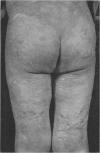Abstract
Phenylketonuria and severe focal scleroderma were observed in a white male child. This is the first instance in which the association of these two rare disorders has been reported. Studies carried out on this patient provide a possible explanation for the abnormalities of indole metabolism in phenylketonuria. On an unrestricted diet, when serum phenylalanine levels were elevated, excessive urinary excretion of indolic tryptophan metabolites was seen 18-24 hours after oral tryptophan loading, and tryptophan was demonstrable in the stool. This was not observed when the serum phenylalanine was within normal limits on a low phenylalanine diet. Impaired intestinal tryptophan absorption secondary to elevated serum phenylalanine, by providing tryptophan substrate for bacterial degradation to indolic compounds which are absorbed and excreted in the urine, may partially explain the abnormalities of indole metabolism in phenylketonuria.
Full text
PDF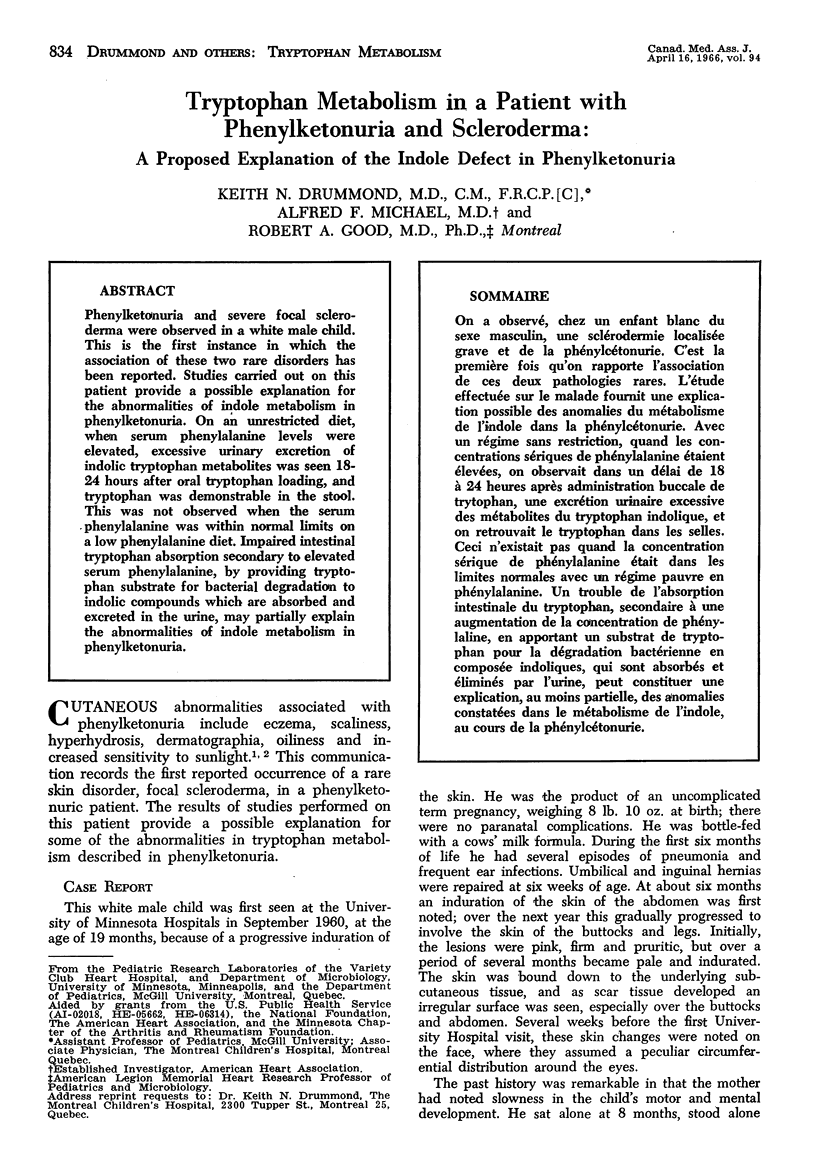
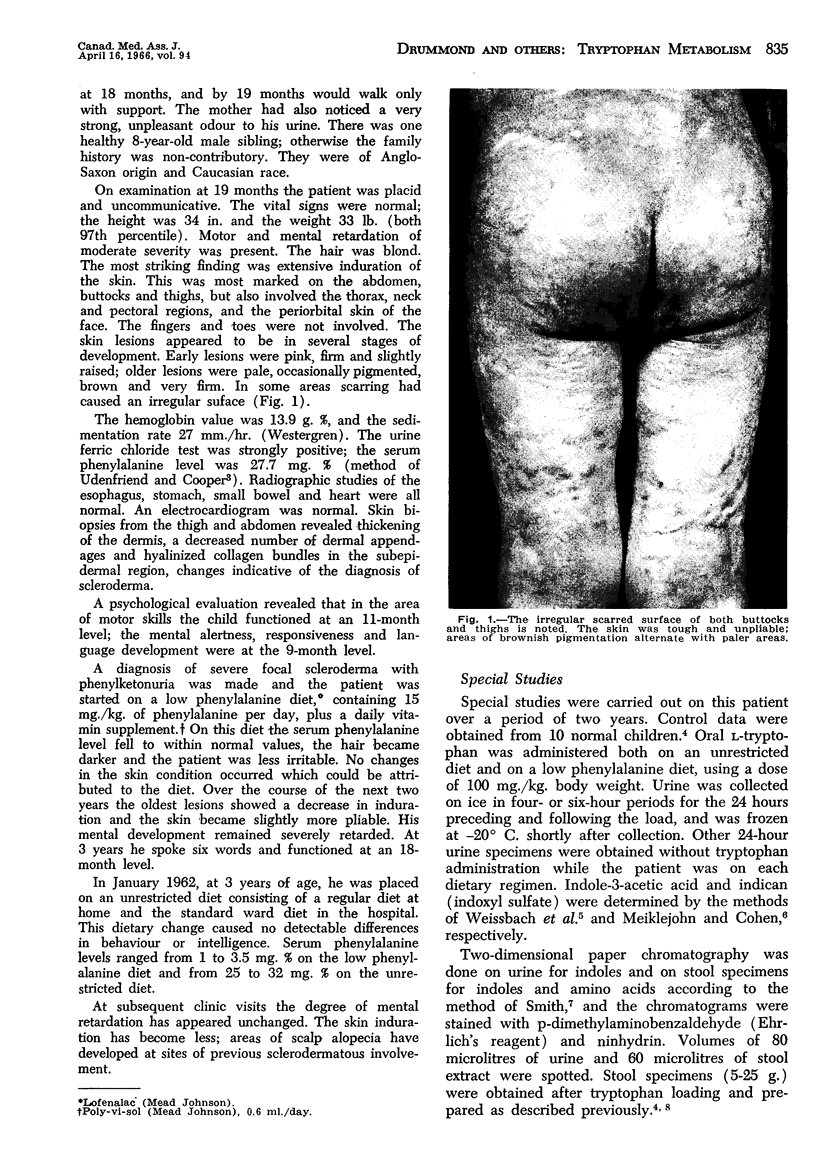
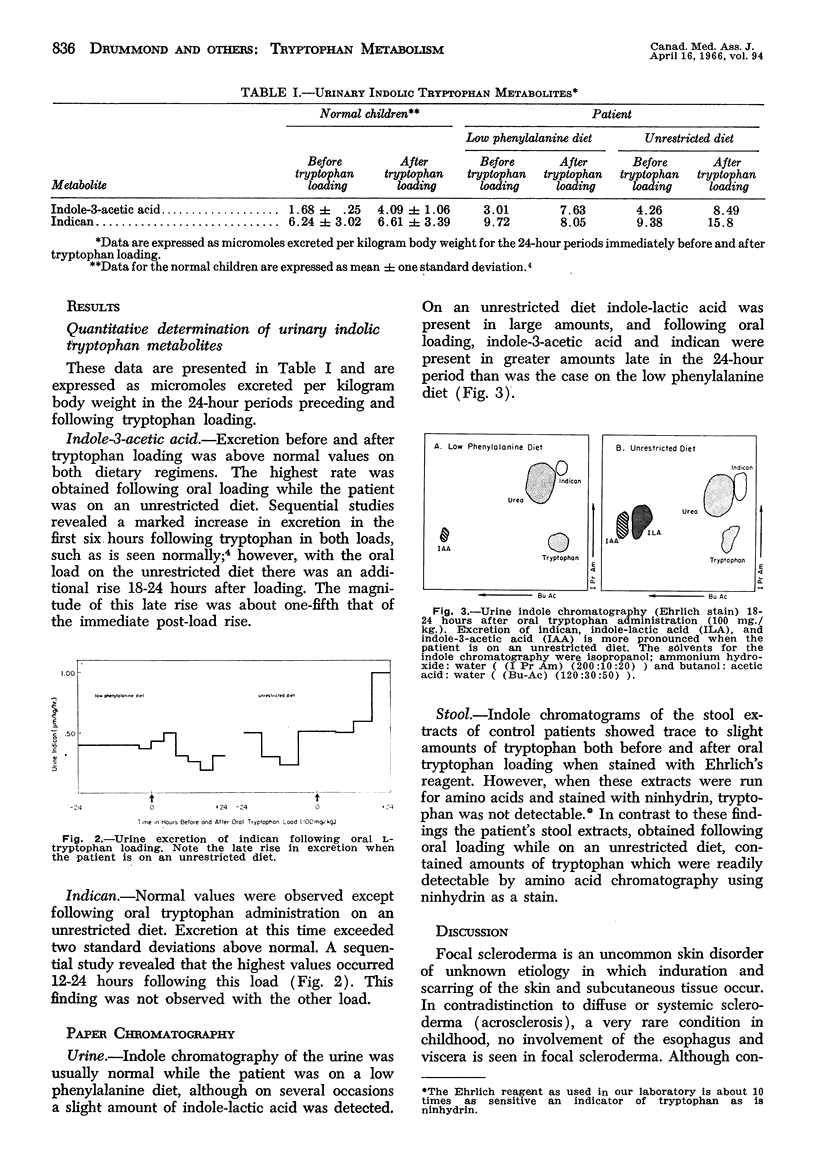
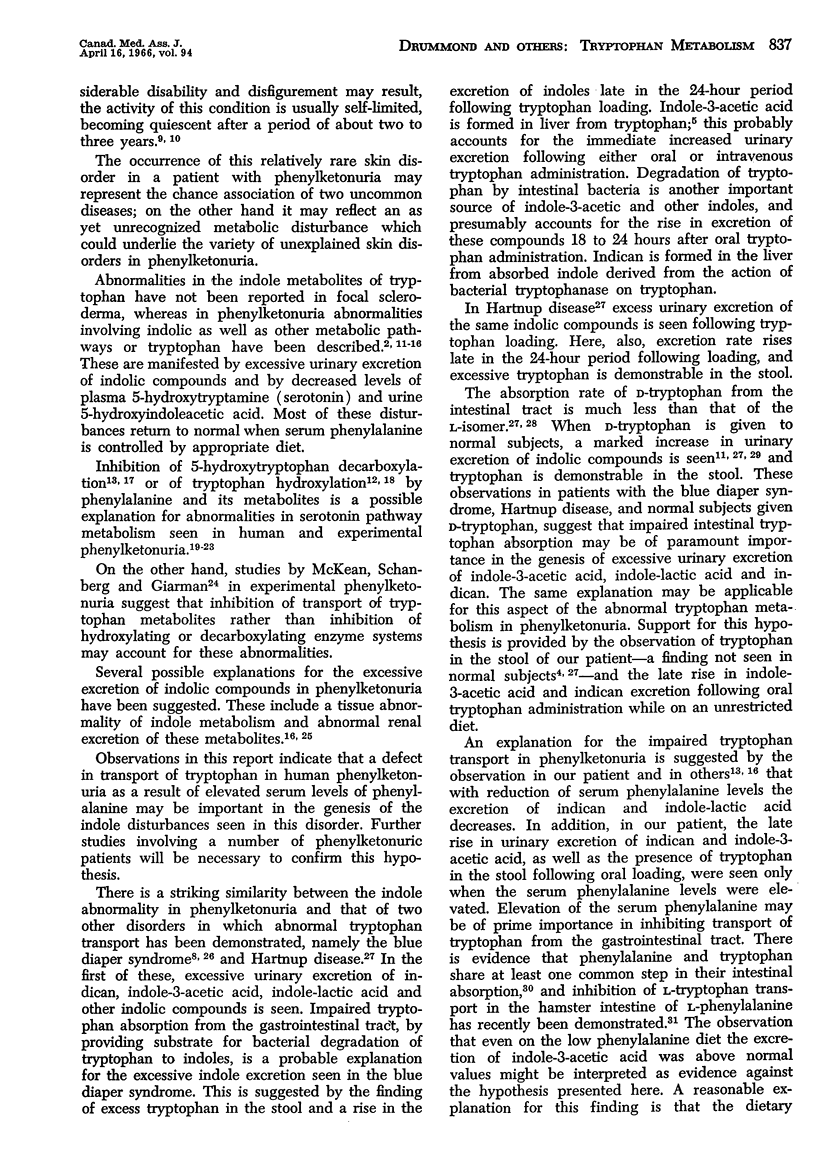
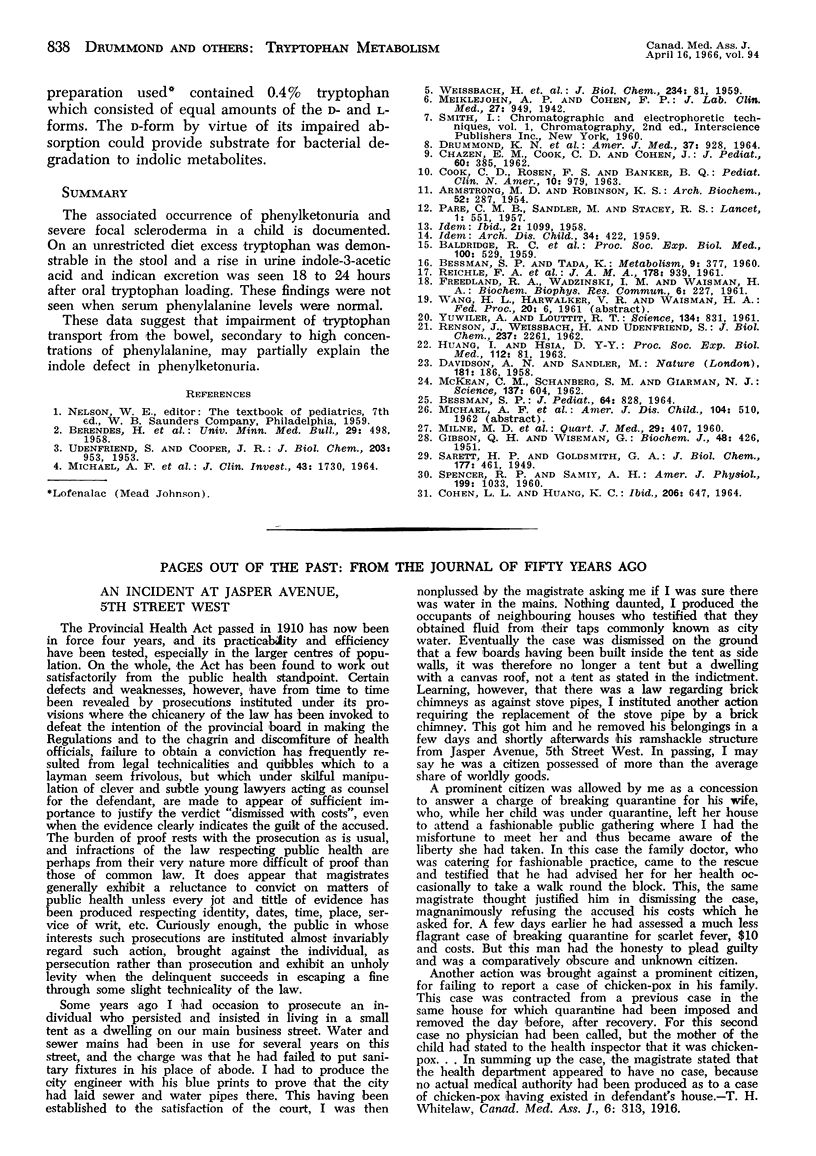
Images in this article
Selected References
These references are in PubMed. This may not be the complete list of references from this article.
- ARMSTRONG M. D., ROBINSON K. S. On the excretion of indole derivatives in phenylketonuria. Arch Biochem Biophys. 1954 Sep;52(1):287–288. doi: 10.1016/0003-9861(54)90115-0. [DOI] [PubMed] [Google Scholar]
- BALDRIDGE R. C., BOROFSKY L., BAIRD H., 3rd, REICHLE F., BULLOCK D. Relationship of serum phenylalanine levels and ability of phenylketonurics to hydroxylate tryptophan. Proc Soc Exp Biol Med. 1959 Mar;100(3):529–531. doi: 10.3181/00379727-100-24686. [DOI] [PubMed] [Google Scholar]
- BESSMAN S. P. SOME BIOCHEMICAL LESSONS TO BE LEARNED FROM PHENYLKETONURIA. J Pediatr. 1964 Jun;64:828–838. doi: 10.1016/s0022-3476(64)80641-7. [DOI] [PubMed] [Google Scholar]
- BESSMAN S. P., TADA K. Indicanuria in phenylketonuria. Metabolism. 1960 Apr;9:377–385. [PubMed] [Google Scholar]
- CHAZEN E. M., COOK C. D., COHEN J. Focal scleroderma. Report of 19 cases in children. J Pediatr. 1962 Mar;60:385–393. doi: 10.1016/s0022-3476(62)80064-x. [DOI] [PubMed] [Google Scholar]
- COHEN L. L., HUANG K. C. INTESTINAL TRANSPORT OF TRYPTOPHAN AND ITS DERIVATIVES. Am J Physiol. 1964 Mar;206:647–652. doi: 10.1152/ajplegacy.1964.206.3.647. [DOI] [PubMed] [Google Scholar]
- COOK C. D., ROSEN F. S., BANKER B. Q. DERMATOMYOSITIS AND FOCAL SCLERODERMA. Pediatr Clin North Am. 1963 Nov;10:979–1016. doi: 10.1016/s0031-3955(16)31477-8. [DOI] [PubMed] [Google Scholar]
- DAVISON A. N., SANDLER M. Inhibition of 5-hydroxytryptophan decarboxylase by phenylalanine metabolites. Nature. 1958 Jan 18;181(4603):186–187. doi: 10.1038/181186b0. [DOI] [PubMed] [Google Scholar]
- DRUMMOND K. N., MICHAEL A. F., ULSTROM R. A., GOOD R. A. THE BLUE DIAPER SYNDROME: FAMILIAL HYPERCALCEMIA WITH NEPHROCALCINOSIS AND INDICANURIA; A NEW FAMILIAL DISEASE, WITH DEFINITION OF THE METABOLIC ABNORMALITY. Am J Med. 1964 Dec;37:928–948. doi: 10.1016/0002-9343(64)90134-2. [DOI] [PubMed] [Google Scholar]
- FREEDLAND R. A., WADZINSKI I. M., WAISMAN H. A. The effect of aromatic amino acids on the hydroxylation of tryptophan. Biochem Biophys Res Commun. 1961 Nov 20;6:227–231. doi: 10.1016/0006-291x(61)90135-8. [DOI] [PubMed] [Google Scholar]
- GIBSON Q. H., WISEMAN G. Selective absorption of stereo-isomers of amino-acids from loops of the small intestine of the rat. Biochem J. 1951 Apr;48(4):426–429. doi: 10.1042/bj0480426. [DOI] [PMC free article] [PubMed] [Google Scholar]
- MICHAEL A. F., DRUMMOND K. N., DOEDEN D., ANDERSON J. A., GOOD R. A. TRYPTOPHAN METABOLISM IN MAN. J Clin Invest. 1964 Sep;43:1730–1746. doi: 10.1172/JCI105048. [DOI] [PMC free article] [PubMed] [Google Scholar]
- MILNE M. D., CRAWFORD M. A., GIRAO C. B., LOUGHRIDGE L. W. The metabolic disorder in Hartnup disease. Q J Med. 1960 Jul;29:407–421. [PubMed] [Google Scholar]
- McKean C. M., Schanberg S. M., Giarman N. J. A Mehanism of the Indole Defect in Experimental Phenylketonuria. Science. 1962 Aug 24;137(3530):604–605. doi: 10.1126/science.137.3530.604. [DOI] [PubMed] [Google Scholar]
- PARE C. M., SANDLER M., STACEY R. S. 5-Hydroxytryptamine deficiency in phenylketonuria. Lancet. 1957 Mar 16;272(6968):551–553. doi: 10.1016/s0140-6736(57)90920-0. [DOI] [PubMed] [Google Scholar]
- REICHLE F. A., BALDRIDGE R. C., DOBBS J., TROMPETTER M. Tryptophan metabolism in phenylketonurics. JAMA. 1961 Dec 2;178:939–941. doi: 10.1001/jama.1961.73040480023018. [DOI] [PubMed] [Google Scholar]
- RENSON J., WEISSBACH H., UDENFRIEND S. Hydroxylation of tryptophan by phenylalanine hydroxylase. J Biol Chem. 1962 Jul;237:2261–2264. [PubMed] [Google Scholar]
- UDENFRIEND S., COOPER J. R. Assay of L-phenylalanine as phenylethylamine after enzymatic decarboxylation; application to isotopic studies. J Biol Chem. 1953 Aug;203(2):953–960. [PubMed] [Google Scholar]
- YUWILER A., LOUTTIT R. T. Effects of phenylalanine diet on brain serotonin in the rat. Science. 1961 Sep 22;134(3482):831–832. doi: 10.1126/science.134.3482.831. [DOI] [PubMed] [Google Scholar]



